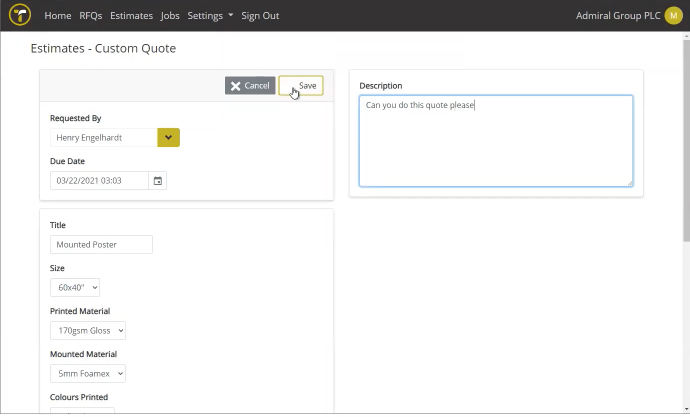Every print company will have a different approach to quoting, with CSRs, account managers and estimators getting involved in different ways. Often it's necessary to have more than one person involved in this process, but this can sometimes lead to delays and create unnecessary work for your skilled estimators.
We recently had a customer approach us with this very problem and wanted to share with you how they overcame their issues by implementing an RFQ workflow.
.png?width=4680&name=MicrosoftTeams-image%20(19).png)
The problem
This customer was unhappy with the turnaround time of their estimates and wanted to make the process more efficient. We helped them delve into the root of the issue, and together we realized that this was not a people problem, nor a technology problem, this was actually a communication problem! Their sales team were submitting estimate requests without providing all of the required specification info. So the estimators were having to chase the missing information, and this was creating delays. The frustrating thing for the company was that 9 times out of 10 this information was actually known by the sales person making the estimate request, it just wasn’t passed on.
The solution
We suggested that they implement an Request for Quote (RFQ) workflow, so that the sales team would be automatically prompted to input all the required data before it reached the estimator. So that's what they did!
The results
By implementing an RFQ workflow the customer not only achieved their initial goal and sped up the turnaround time of estimates, they also saw an increase in sales conversion rates which they attributed to their new speedy response times.
How to implement an RFQ workflow in your print business
Your first step is to have a bit of a brainstorming session with your team and consider the following questions:

- What information do our estimators need to create a quote? (Top tip - Make sure this is just NEED to have, and not NICE to have - if you make the RFQ request too onerous, you could end up with people reverting to their old ways.)
- How and where are we going to capture that information?
- How does that information reach the estimators?
- Who needs training on the new RFQ process and how shall we deliver it?
For the answers to the second and third questions, you might want to speak to your MIS partner and ask them for their advice, but here's the two recommendations we generally make to our own customers:
- Create a web page that contains a custom form where your sales team can populate all the required information for a quote. Once submitted, the web page should call the API of your MIS solution and send all that information to your MIS in the form of an RFQ task.
- This one's just for Tharstern customers but your own MIS partner may provide a similar tool. Using our Remote Access Portal, users can carry out the same process as above using a customizable RFQ request form (see screenshot below). The RFQ request is sent automatically into the main MIS solution, along with artwork attachments, and the estimators can access it from their RFQ list within Tharstern.

However you decide to implement your RFQ workflow, you will almost certainly see an improvement in turnaround times but you may see other benefits too. If you've used technology to drive this process, the data that's being collected will allow you to report on response times and monitor SLA commitments.
Want to take it one step further? You could even roll out your RFQ web page to certain customers and let them create their own RFQs where possible - now that's a great customer experience!